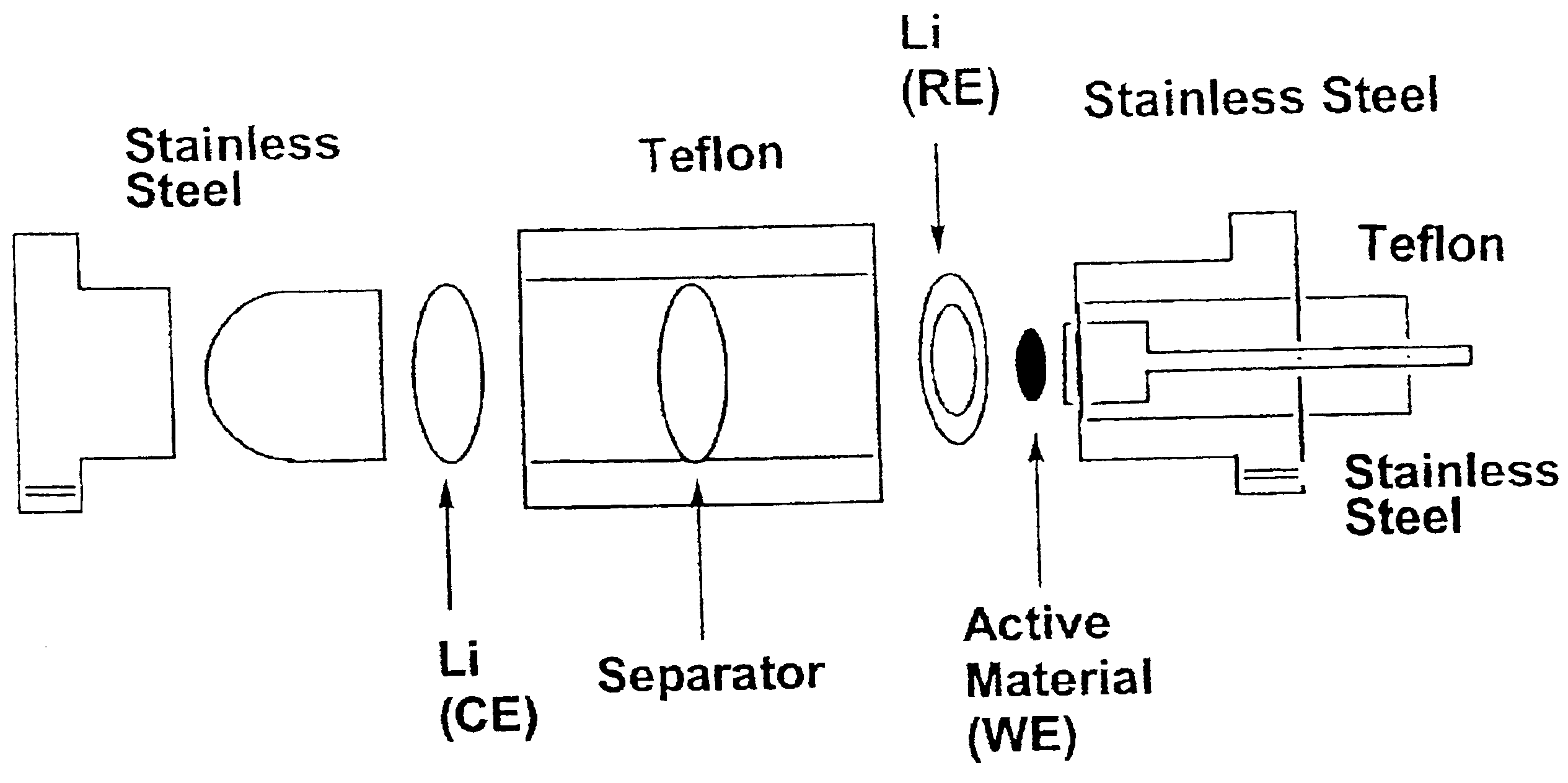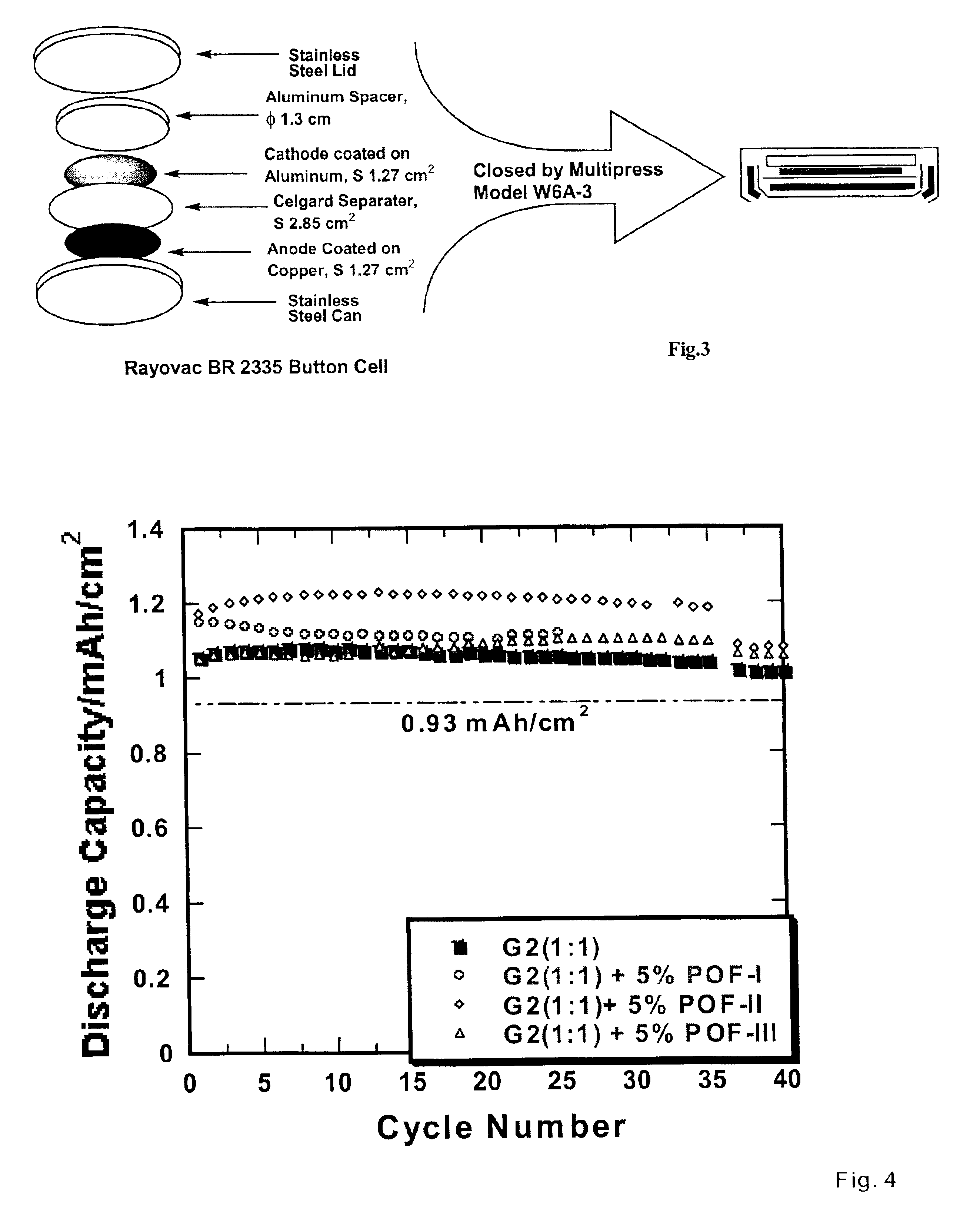Nonflammable non-aqueous electrolyte and non-aqueous electrolyte cells comprising the same
- Summary
- Abstract
- Description
- Claims
- Application Information
AI Technical Summary
Benefits of technology
Problems solved by technology
Method used
Image
Examples
example 1
Synthesis of tris(trifluoroethyl) Phosphate (POF-I)
[0043]122.65 g (0.80 mole) phosphorus oxychloride (POCl3, Aldrich, 99%) was added drop-wise to a mixture of 400 mL dry acetonitrile (Aldrich 99%), 253 g (2.50 mole) triethylamine (TCI, 99%), and 250 g (2.50 mole) trifluoroethanol (Lancaster, 99+%) under vehement stirring at about 0-5° C. After the addition was completed, the mixture was refluxed for 1 hour. Ammonium salt was filtered and filtrate was washed by NaCl saturated distilled water. The resultant organic phase was dried over MgSO4 and then fractionated 3 times. Final distillates of POF-I between 188 and 193° C. were collected.
[0044]1H-NMR: 4.433(quintuplet, JP-H=8.002 Hz); 13C-NMR: 122.01 (octet, JC-P=10.06 Hz, JC-F=277.33 Hz); 64.261 (octet, JC-P=4.276 Hz, JC-F=38.61 Hz); 19F-NMR: −76.78 (triplet, JF-H=8.00 Hz); 31P-NMR: −2.538 (singlet).
[0045]The purified POF-I was further dried over neutral alumina in a glove box before being used as an electrolyte solvent. Karl-Fischer ...
example 2
Synthesis of bis(trifluoroethyl)methyl Phosphate (POF-II)
[0046]100 g (0.67 mole) Methyldichlorophosphate (MePOCl2, Aldrich, 97%) was added drop-wise to a mixture of 300 mL anhydrous ether (Fischer, 99%), 131.93 g (1.67 mole) pyridine (Aldrich, 99%), and 167.6 g (1.67 mole) trifluoroethanol (Lancaster, 99+%) under vehement stirring at approximately 0-5° C. After addition was completed, the mixture was refluxed for 2 hours. The reaction mixture was cooled in refrigerator and pyridinium salt was then filtered. The filtrate was washed first by 10% sulfuric acid solution in NaCl saturated distilled water and then by NaCl saturated distilled water alone until a of pH approximately 7.0 was realized. The resultant organic phase was dried over MgSO4 and then fractionated 3 times. Final distillates of POF-II between 48 and 53° C. / 1.0 mmHg were collected.
[0047]1H-NMR: 1.02 (singlet, 3H); 4.321 (quintuplet, JP-H=8.40 Hz, 4H); 13C-NMR: 15.70 (doublet, JP-C=7.00 Hz); 65.00 (quartet, JF-C=127.0 Hz...
example 3
Synthesis of Diethyltrifluoroethyl Phosphate (POF-III)
[0050]100 g (0.5795 mole) diethyl chlorophosphate (Et2POCl, Aldrich, 97%) was added drop-wise to a mixture of 300 ml dry acetonitrile (Aldrich, 99%), 45.36 g (0.62 mole) diethylmethylamine (TCI, 99+%), and 57.97 g (0.58 mole) trifluoroethanol (Lancaster, 99%) under vehement stirring. After the addition was completed, the mixture was refluxed for 2 hours. Ammonium salt was filtered and the filtrate was fractionated 3 times. Final distillates of POF-III between 80-82° C. / 2.5 mmHg were collected.
[0051]1H-NMR: 1.37 (triplet, JH-H=4.006 Hz, 6H); 4.169 (quintuplet, JP-H=7.60 Hz, 4H); 4.351 (quintuplet, JP-H=8.40 Hz, 2H); 13C-NMR: 15.74 (doublet, JP-C=7.04 Hz); 63.12 (quartet, JF-C=126.77 Hz, JP-C=4.02 Hz); 64.24 (singlet, JP-C=6.03 Hz); 19F-NMR: 74.7 (singlet); 31P-NMR: −1.337 (heptet, JP-H=7.936 Hz).
[0052]MS: 236 (M+); 221 (M—CH3); 209 (M—C2H4); 181 (M—C4H8).
PUM
 Login to View More
Login to View More Abstract
Description
Claims
Application Information
 Login to View More
Login to View More - R&D
- Intellectual Property
- Life Sciences
- Materials
- Tech Scout
- Unparalleled Data Quality
- Higher Quality Content
- 60% Fewer Hallucinations
Browse by: Latest US Patents, China's latest patents, Technical Efficacy Thesaurus, Application Domain, Technology Topic, Popular Technical Reports.
© 2025 PatSnap. All rights reserved.Legal|Privacy policy|Modern Slavery Act Transparency Statement|Sitemap|About US| Contact US: help@patsnap.com



